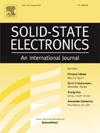一步变型包括条件变分自编码器的紧凑建模
IF 1.4
4区 物理与天体物理
Q3 ENGINEERING, ELECTRICAL & ELECTRONIC
引用次数: 0
摘要
高效、准确的变差建模是电路评估的重要组成部分,它可以再现半导体器件的实际电学行为。传统的变化建模通常包括两个步骤:对MOSFET制造过程中引入的基本电学特性进行紧凑建模和对变化源进行子建模,主要是结构和掺杂参数。这个漫长的过程导致了器件生产和快速电路分析之间的差距。为了提高建模效率,在这项工作中,我们提出了一种利用机器学习的一步包含变量的紧凑建模方法。利用条件变分自编码器(conditional variational autoencoder, cVAE),自动提取cVAE模型的变分源,省去了子建模步骤,直接构建了具有变化的电流。以蒙特卡罗模拟BSIM-CMG生成的数据集的先验分布为基准,cVAE生成的I-V曲线的归一化方差FoMs均在0.9以上。在SPICE中实现该模型后,电路级变化建模的高精度也表明了该模型的潜力。本文章由计算机程序翻译,如有差异,请以英文原文为准。
One-step variation included compact modeling with conditional variational autoencoder
Efficient and accurate variation modeling serves as a critical part in circuit evaluation, which can reproduce actual electrical behavior of semiconductor devices. Conventional variation modeling usually consists of two steps: compact modeling the basic electrical properties and sub-modeling the variation sources introduced in MOSFET manufacturing process, mostly structural and doping parameters. This lengthy process results in a gap between device production and rapid circuit analysis. In order to improve modeling efficiency, in this work, we propose a one-step variation-included compact modeling approach leveraging machine learning. Utilizing conditional variational autoencoder (cVAE), currents with variation are directly constructed without the sub-modeling step, as variation sources of the cVAE model are automatically extracted. Benchmark against prior distribution of dataset generated by Monte Carlo simulation of BSIM-CMG, normalized variation in figure of merits (FoMs) of cVAE generated I-V curves are all above 0.9. After implementing the model in SPICE, high accuracy in circuit-level variation modeling also indicates the potential of the proposed model.
求助全文
通过发布文献求助,成功后即可免费获取论文全文。
去求助
来源期刊

Solid-state Electronics
物理-工程:电子与电气
CiteScore
3.00
自引率
5.90%
发文量
212
审稿时长
3 months
期刊介绍:
It is the aim of this journal to bring together in one publication outstanding papers reporting new and original work in the following areas: (1) applications of solid-state physics and technology to electronics and optoelectronics, including theory and device design; (2) optical, electrical, morphological characterization techniques and parameter extraction of devices; (3) fabrication of semiconductor devices, and also device-related materials growth, measurement and evaluation; (4) the physics and modeling of submicron and nanoscale microelectronic and optoelectronic devices, including processing, measurement, and performance evaluation; (5) applications of numerical methods to the modeling and simulation of solid-state devices and processes; and (6) nanoscale electronic and optoelectronic devices, photovoltaics, sensors, and MEMS based on semiconductor and alternative electronic materials; (7) synthesis and electrooptical properties of materials for novel devices.
 求助内容:
求助内容: 应助结果提醒方式:
应助结果提醒方式:


